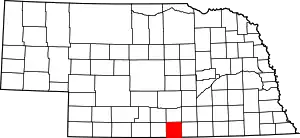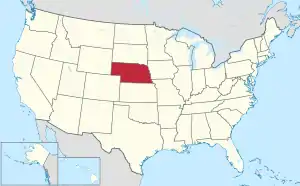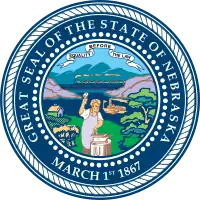Franklin County, Nebraska
Franklin County is a county in the U.S. state of Nebraska. As of the 2010 census, the population was 3,225.[1] Its county seat is Franklin.[2] The county was formed in 1867 and organized in 1871.[3][4] It was named for Benjamin Franklin.[5]
Franklin County | |
|---|---|
_Courthouse_from_E.JPG.webp) Franklin County courthouse in Franklin | |
 Location within the U.S. state of Nebraska | |
 Nebraska's location within the U.S. | |
| Coordinates: 40°11′N 98°57′W | |
| Country | |
| State | |
| Founded | 1867 (authorized) 1871 (organized) |
| Named for | Benjamin Franklin |
| Seat | Franklin |
| Largest city | Franklin |
| Area | |
| • Total | 576 sq mi (1,490 km2) |
| • Land | 576 sq mi (1,490 km2) |
| • Water | 0.2 sq mi (0.5 km2) 0.03%% |
| Population | |
| • Estimate (2017) | 2,990 |
| • Density | 5.2/sq mi (2.0/km2) |
| Time zone | UTC−6 (Central) |
| • Summer (DST) | UTC−5 (CDT) |
| Congressional district | 3rd |
| Website | www |
In the Nebraska license plate system, Franklin County is represented by the prefix 50 (it had the 50th-largest number of vehicles registered in the county when the license plate system was established in 1922).
Geography
Franklin County lies on the south line of Nebraska. Its south boundary line abuts the north boundary line of the state of Kansas. The Republican River flows eastward through the southern part of Franklin County.[6]
According to the US Census Bureau, the county has a total area of 576 square miles (1,490 km2), of which 576 square miles (1,490 km2) is land and 0.2 square miles (0.52 km2) (0.03%) is water.[7]
Major highways
Adjacent counties
- Kearney County - north
- Webster County - east
- Smith County, Kansas - southeast
- Phillips County, Kansas - southwest
- Harlan County - west
- Phelps County - northwest
Demographics
| Historical population | |||
|---|---|---|---|
| Census | Pop. | %± | |
| 1870 | 26 | — | |
| 1880 | 5,465 | 20,919.2% | |
| 1890 | 7,693 | 40.8% | |
| 1900 | 9,455 | 22.9% | |
| 1910 | 10,303 | 9.0% | |
| 1920 | 10,067 | −2.3% | |
| 1930 | 9,094 | −9.7% | |
| 1940 | 7,740 | −14.9% | |
| 1950 | 7,096 | −8.3% | |
| 1960 | 5,449 | −23.2% | |
| 1970 | 4,566 | −16.2% | |
| 1980 | 4,377 | −4.1% | |
| 1990 | 3,938 | −10.0% | |
| 2000 | 3,574 | −9.2% | |
| 2010 | 3,225 | −9.8% | |
| 2017 (est.) | 2,990 | [8] | −7.3% |
| US Decennial Census[9] 1790-1960[10] 1900-1990[11] 1990-2000[12] 2010-2013[1] | |||
As of the 2000 United States Census,[13] there were 3,574 people, 1,485 households, and 1,021 families in the county. The population density was 6 people per square mile (2/km2). There were 1,746 housing units at an average density of 3 per square mile (1/km2). The racial makeup of the county was 99.24% White, 0.28% Native American, 0.06% Asian, 0.08% from other races, and 0.34% from two or more races. 0.64% of the population were Hispanic or Latino of any race. 63.5% were of German, 6.8% American, 6.6% English and 5.7% Irish ancestry.
There were 1,485 households, out of which 28.60% had children under the age of 18 living with them, 59.40% were married couples living together, 6.00% had a female householder with no husband present, and 31.20% were non-families. 29.20% of all households were made up of individuals, and 16.00% had someone living alone who was 65 years of age or older. The average household size was 2.34 and the average family size was 2.87.
The county population contained 24.50% under the age of 18, 4.50% from 18 to 24, 23.60% from 25 to 44, 23.50% from 45 to 64, and 23.90% who were 65 years of age or older. The median age was 43 years. For every 100 females there were 92.80 males. For every 100 females age 18 and over, there were 91.00 males.
The median income for a household in the county was $29,304, and the median income for a family was $34,958. Males had a median income of $26,192 versus $18,214 for females. The per capita income for the county was $15,390. About 9.70% of families and 13.20% of the population were below the poverty line, including 17.20% of those under age 18 and 9.40% of those age 65 or over.
Politics
Franklin County voters have been reliably Republican for decades. In no national election since 1964 has the county selected the Democratic Party candidate (as of 2016).
| Year | Republican | Democratic | Third Parties |
|---|---|---|---|
| 2016 | 80.5% 1,347 | 14.9% 250 | 4.5% 76 |
| 2012 | 72.4% 1,112 | 25.0% 384 | 2.6% 40 |
| 2008 | 69.5% 1,079 | 28.5% 442 | 2.0% 31 |
| 2004 | 74.5% 1,277 | 24.0% 412 | 1.5% 25 |
| 2000 | 71.7% 1,196 | 25.2% 420 | 3.1% 52 |
| 1996 | 59.0% 1,013 | 28.2% 483 | 12.8% 220 |
| 1992 | 48.9% 969 | 24.1% 477 | 27.1% 537 |
| 1988 | 62.1% 1,294 | 36.8% 768 | 1.1% 23 |
| 1984 | 75.1% 1,597 | 24.5% 522 | 0.4% 8 |
| 1980 | 74.0% 1,675 | 19.5% 441 | 6.6% 149 |
| 1976 | 54.1% 1,170 | 43.5% 941 | 2.4% 52 |
| 1972 | 71.6% 1,510 | 28.4% 599 | |
| 1968 | 65.0% 1,447 | 28.1% 626 | 6.8% 152 |
| 1964 | 46.8% 1,241 | 53.2% 1,409 | |
| 1960 | 64.2% 1,798 | 35.8% 1,003 | |
| 1956 | 68.8% 1,955 | 31.2% 888 | |
| 1952 | 75.9% 2,438 | 24.1% 775 | |
| 1948 | 53.7% 1,555 | 46.3% 1,340 | |
| 1944 | 68.3% 2,085 | 31.7% 969 | |
| 1940 | 63.1% 2,354 | 36.9% 1,378 | |
| 1936 | 40.5% 1,685 | 56.4% 2,350 | 3.1% 130 |
| 1932 | 34.3% 1,404 | 64.4% 2,633 | 1.3% 54 |
| 1928 | 63.4% 2,533 | 36.1% 1,443 | 0.4% 17 |
| 1924 | 51.3% 1,920 | 35.5% 1,331 | 13.2% 494 |
| 1920 | 67.4% 2,294 | 30.3% 1,030 | 2.3% 79 |
| 1916 | 43.2% 1,081 | 53.8% 1,345 | 3.0% 74 |
| 1912 | 14.2% 332 | 48.9% 1,148 | 36.9% 867 |
| 1908 | 43.7% 1,083 | 52.4% 1,298 | 3.8% 95 |
| 1904 | 58.6% 1,269 | 21.7% 471 | 19.7% 427 |
| 1900 | 45.5% 984 | 51.9% 1,122 | 2.7% 58 |
References
- "State & County QuickFacts". US Census Bureau. Archived from the original on June 7, 2011. Retrieved September 19, 2013.
- "Find a County". National Association of Counties. Archived from the original on 31 May 2011. Retrieved 7 June 2011.
- Fitzpatrick, Lilian Linder (1925). Nebraska Place-Names. Lincoln: University of Nebraska Studies in Language, Literature, and Criticism. p. 60. Retrieved December 14, 2014.
- Andreas, A. T. (1882). "Andreas' History of the State of Nebraska". The Kansas Collection. Archived from the original on 2003-05-08. Retrieved December 14, 2014.
- Gannett, Henry (1905). The Origin of Certain Place Names in the United States. Govt. Print. Off. p. 131.
- Burr, George L. (1921). History of Hamilton and Clay Counties, Nebraska, Vol. 1. S.J. Clarke Pub. Co. p. 110.
- "2010 Census Gazetteer Files". US Census Bureau. August 22, 2012. Archived from the original on November 13, 2013. Retrieved December 7, 2014.
- "Population and Housing Unit Estimates". Retrieved 20 January 2019.
- "US Decennial Census". US Census Bureau. Retrieved December 7, 2014.
- "Historical Census Browser". University of Virginia Library. Retrieved December 7, 2014.
- "Population of Counties by Decennial Census: 1900 to 1990". US Census Bureau. Retrieved December 7, 2014.
- "Census 2000 PHC-T-4. Ranking Tables for Counties: 1990 and 2000" (PDF). US Census Bureau. Retrieved December 7, 2014.
- "U.S. Census website". US Census Bureau. Retrieved 31 January 2008.
- Macon NE Google Maps (accessed 20 January 2019)
- Election Results
